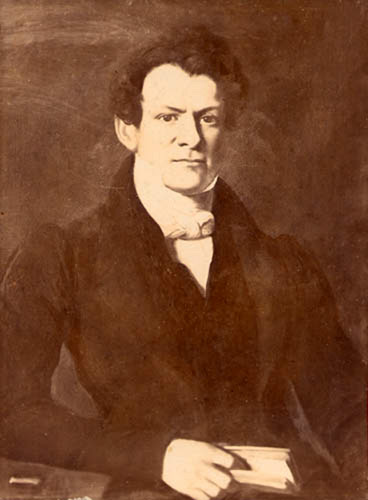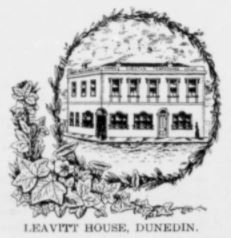|
Juliet Valpy
Juliet Anna Owen Valpy Mackworth (23 August 1835 – 9 April 1911) was a New Zealand artist, and one of six children of William Henry Valpy and Caroline Valpy (born Jeffreys), a pioneering family who arrived in Dunedin, New Zealand in January 1849 aboard the ''Ajax''. She was born in Sikraul Varanasi, Uttar Pradesh, India, where her father was a judge. She married William Mackworth at her parents' home The Forbury, Dunedin, on 22 September 1852, in a double wedding with her sister Catherine, who was marrying James Fulton. Three days after the wedding, their father unexpectedly died. Mackworth and Valpy had a daughter, Wilhelmina, but Mackworth died while she was an infant. Valpy married Bayly Pike, and had four children with him. Her watercolour paintings survive in the Hocken Collections Hocken Collections (, formerly the Hocken Library) is a research library, historical archive, and art gallery based in Dunedin, New Zealand. Its library collection, which is of national signi ... [...More Info...] [...Related Items...] OR: [Wikipedia] [Google] [Baidu] |
William Henry Valpy
William Henry Valpy (2 January 1793 – 25 September 1852) was a noted early settler of Dunedin, New Zealand. He is sometimes referred to locally as "The father of Saint Clair", as he was the first settler in the area now occupied by the suburb of Saint Clair. Valpy was born in Reading, Berkshire, the son of English educationalist Richard Valpy and the younger brother of the English printer and publisher Abraham John Valpy. On 12 January 1810, Valpy petitioned the East India Company, with support from director William Astell, for admission to the East-India College with a view to obtaining a post with the Company in Bengal. In due course, Valpy was appointed a Magistrate & Collector. The responsibility of the role was the maintenance of law and order, and the collection of revenue. The role continues to exist in India in modified form as the District Magistrate. Valpy married Caroline Jeffreys (born 1804 in Kolkata) in Kanpur on the 1st of May 1826. Valpy's Magistrat ... [...More Info...] [...Related Items...] OR: [Wikipedia] [Google] [Baidu] |
Caroline Valpy
Caroline Penelope Valpy (née Jeffreys; 1804 – 30 October 1884) was a British-New Zealand artist. Biography Caroline Valpy was born Caroline Penelope Jeffreys in Kanpur, India in 1804 to Reverend Richard Jeffreys, chaplain to the East India Company. She was sister to Reverend Charles Jeffreys. Valpy married William Henry Valpy in India. They had six children: Ellen Jeffreys, Catherine Fulton, Arabella Valpy, Juliet Valpy, William Henry Valpy, Jr. and Caroline Hensley. They moved to England in 1837, before coming to Dunedin, New Zealand aboard the ''Ajax'' in 1849. They lived at Forbury, Dunedin, close to the current suburban road, Valpy Street. Valpy and her daughters, especially Ellen, were known to be talented artists. They are described as having filled numerous notebooks with drawings and watercolours. Valpy's artwork is represented in the Otago Early Settlers' Association, Dunedin. Valpy's artwork, ''Early Dunedin 1851'', is also recorded as being reproduced in a ... [...More Info...] [...Related Items...] OR: [Wikipedia] [Google] [Baidu] |
Dunedin
Dunedin ( ; mi, Ōtepoti) is the second-largest city in the South Island of New Zealand (after Christchurch), and the principal city of the Otago region. Its name comes from , the Scottish Gaelic name for Edinburgh, the capital of Scotland. The city has a rich Scottish, Chinese and Māori heritage. With an estimated population of as of , Dunedin is both New Zealand's seventh-most populous metro and urban area. For historic, cultural and geographic reasons the city has long been considered one of New Zealand's four main centres. The urban area of Dunedin lies on the central-eastern coast of Otago, surrounding the head of Otago Harbour, and the harbour and hills around Dunedin are the remnants of an extinct volcano. The city suburbs extend out into the surrounding valleys and hills, onto the isthmus of the Otago Peninsula, and along the shores of the Otago Harbour and the Pacific Ocean. Archaeological evidence points to lengthy occupation of the area by Māori prior to the ar ... [...More Info...] [...Related Items...] OR: [Wikipedia] [Google] [Baidu] |
Uttar Pradesh
Uttar Pradesh (; , 'Northern Province') is a state in northern India. With over 200 million inhabitants, it is the most populated state in India as well as the most populous country subdivision in the world. It was established in 1950 after India had become a republic. It was a successor to the United Provinces (UP) during the period of the Dominion of India (1947–1950), which in turn was a successor to the United Provinces (UP) established in 1935, and eventually of the United Provinces of Agra and Oudh established in 1902 during the British Raj. The state is divided into 18 divisions and 75 districts, with the state capital being Lucknow, and Prayagraj serving as the judicial capital. On 9 November 2000, a new state, Uttaranchal (now Uttarakhand), was created from Uttar Pradesh's western Himalayan hill region. The two major rivers of the state, the Ganges and its tributary Yamuna, meet at the Triveni Sangam in Prayagraj, a Hindu pilgrimage site. Ot ... [...More Info...] [...Related Items...] OR: [Wikipedia] [Google] [Baidu] |
Catherine Fulton
Catherine Henrietta Elliot Fulton (née Valpy, 19 December 1829 – 6 May 1919) was a New Zealand diarist, community leader, philanthropist, social reformer and suffragist. She was a founding member of the Dunedin chapter of Women's Christian Temperance Union of New Zealand (WCTU NZ) in 1885 and national president of the WCTU NZ from 1889 to 1892. Early life Fulton was one of six children born to William Henry Valpy and Caroline Valpy (née Jeffreys). She was born in Cheltenham, Gloucestershire or in Reading, Berkshire, England on 19 December 1829. She was educated in England and arrived in New Zealand on the ''Ajax'' in January 1849. Public life Fulton married James Fulton in 1852 and moved to his farm "Ravenscliffe" on the Taieri Plains, Otago. Together they had eight children, several of whom became notable in their own right (most famously the engineers Arthur and James Edward Fulton). Fulton was the national President of the Women's Christian Temperance Union (WCTU) ... [...More Info...] [...Related Items...] OR: [Wikipedia] [Google] [Baidu] |
James Fulton (New Zealand Politician)
James Fulton (27 June 1830 – 20 November 1891) was a 19th-century Member of Parliament in Otago, New Zealand and a cricketer. Biography James Fulton was born in Bengal, and went to New Zealand in the late 1840s. On 22 September 1852, he married Catherine Valpy, a daughter of one of Dunedin's most prominent and prosperous families. His wife was to become a notable suffragette. They had three sons and three daughters. His two eldest sons, Arthur Fulton (1853-1889) and James Edward Fulton (1854-1928) were prominent civil engineers. He played five first-class cricket matches for Otago between 1863 and 1868. These were the first five first-class matches played in New Zealand, and scores were very low. He made the top score of the match in the first two matches: 25 not out in the first match, which Otago won, and 22 in the second, which Canterbury won. He captained Otago in three of his matches. For many years he was resident magistrate at Outram, a small town west of ... [...More Info...] [...Related Items...] OR: [Wikipedia] [Google] [Baidu] |
Otago Witness
The ''Otago Witness'' was a prominent illustrated weekly newspaper in the early years of the European settlement of New Zealand, produced in Dunedin, the provincial capital of Otago. Published weekly it existed from 1851 to 1932. The introduction of the Otago Daily Times followed by other daily newspapers in its circulation area lead it to focus on serving a rural readership in the lower South Island where poor road access prevented newspapers being delivered daily. It also provided an outlet for local fiction writers. It is notable as the first newspaper to use illustrations and photographs and was the first New Zealand newspaper to provide a correspondence column for children, which was known as "Dot's Little Folk". Together with the Auckland based ''Weekly News'' and the Wellington based ''New Zealand Free Lance'' it was one of the most significant illustrated weekly New Zealand newspapers in the 19th and early 20th centuries. History Background Nine months after the first immi ... [...More Info...] [...Related Items...] OR: [Wikipedia] [Google] [Baidu] |
Hocken Collections
Hocken Collections (, formerly the Hocken Library) is a research library, historical archive, and art gallery based in Dunedin, New Zealand. Its library collection, which is of national significance, is administered by the University of Otago. The Collections' specialist areas include items relating to the history of New Zealand and the Pacific, with specific emphasis on the Otago and Southland Regions. Open to the general public, the library is one of the country's most important historical research facilities. History Hocken Collections is the result of the philanthropy of avid collector Dr. Thomas Hocken, who donated his private collection to the university in trust for the New Zealand public. Hocken first made public his intention to offer his library to the people of New Zealand in 1897. A deed of gift was signed on 3 September 1907 but it was not until 1910 that it became generally accessible in a purpose built wing of the Otago Museum. Dr. Thomas Hocken was too ill to at ... [...More Info...] [...Related Items...] OR: [Wikipedia] [Google] [Baidu] |
Artists From Dunedin
An artist is a person engaged in an activity related to creating art, practicing the arts, or demonstrating an art. The common usage in both everyday speech and academic discourse refers to a practitioner in the visual arts only. However, the term is also often used in the entertainment business, especially in a business context, for musicians and other performers (although less often for actors). "Artiste" (French for artist) is a variant used in English in this context, but this use has become rare. Use of the term "artist" to describe writers is valid, but less common, and mostly restricted to contexts like used in criticism. Dictionary definitions The ''Oxford English Dictionary'' defines the older broad meanings of the term "artist": * A learned person or Master of Arts. * One who pursues a practical science, traditionally medicine, astrology, alchemy, chemistry. * A follower of a pursuit in which skill comes by study or practice. * A follower of a manual art, such as a m ... [...More Info...] [...Related Items...] OR: [Wikipedia] [Google] [Baidu] |
1835 Births
Events January–March * January 7 – anchors off the Chonos Archipelago on her second voyage, with Charles Darwin on board as naturalist. * January 8 – The United States public debt contracts to zero, for the only time in history. * January 24 – Malê Revolt: African slaves of Yoruba Muslim origin revolt in Salvador, Bahia. * January 26 – Queen Maria II of Portugal marries Auguste de Beauharnais, 2nd Duke of Leuchtenberg, in Lisbon; he dies only two months later. * January 26 – Saint Paul's in Macau largely destroyed by fire after a typhoon hits. * January 30 – An assassination is attempted against United States President Andrew Jackson in the United States Capitol (the first assassination attempt against a President of the United States). * February 1 – Slavery is abolished in Mauritius. * February 20 – 1835 Concepción earthquake: Concepción, Chile, is destroyed by an earthquake; the resulting tsunami destroys the neighboring city of Talcahua ... [...More Info...] [...Related Items...] OR: [Wikipedia] [Google] [Baidu] |







